Further Up the Allegheny
August 9, 2009
My plan had been to sail very often on the rivers this summer. Somehow, there always seemed to be some reason not to go. After the last sail, Eve and I went on a lovely vacation in Nantucket for a week. Then there had been the Forrest Wood Bass Fishing Tournament and I was pretty sure the competing anglers would not welcome a sailboat grazing past their lines. Finally, I was out of town in Halifax, Nova Scotia, for a conference.
All this was not a write-off for sailing. In Nantucket and then in Halifax, I saw lots of sailing history. The old wooden sailboats are quite glorious. No doubt the maintenance on one would be life consuming, so I'll stick with unromantic plastic hulls. What was striking was how new our common sailing rigs are. Virtually all modern, small sailboats have a "Bermuda" rig. It has two simple triangular sails, hoisted up the mast. While these rigs were seen 100 years ago, many other sail plans were used. A common one is the "gaff rigged" boat. In it the mainsail has a second boom, called the "gaff," high up, so the sail is a truncated triangle. The great advantage is that the boat needs a shorter mast.
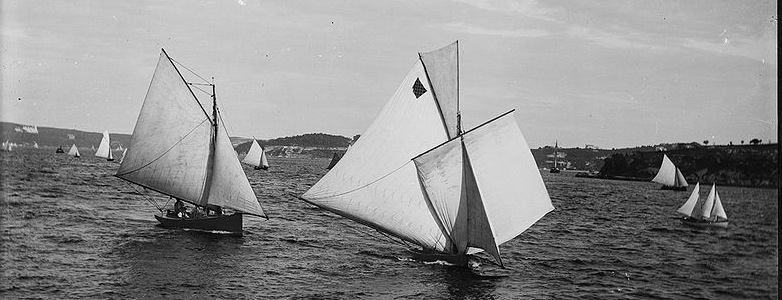
Finally on this Sunday, the conditions had come together. Through the past week, the river currents had been high. There had been heavy rain over the weekend I'd spent in Halifax. Now the currents were down to around 9,000 cubic feet per second on the Allegheny and the mere trickle of 1,600 cubit feet per second on the Mon. The winds, however, had been forecast to be strong. On Thursday and Friday, I'd seen a high of 17 mph forecast. That was a little too windy for me. By Sunday morning, the forecast was down to 11-13 mph. That seemed more manageable, but, I will admit to being a little apprehensive. The wind direction was a steady WSW. I prefer NW since that blows down the Ohio near my marina. But WSW was close enough, I supposed, incorrectly.
I set off on my bicycle with my sailing gear. A lot happens in downtown Pittsburgh. This Sunday, there was a Pirates babseball game at the stadium. So I weaved my way past t-shirt vendors and over the 6th Street Bridge, which was closed to cars.
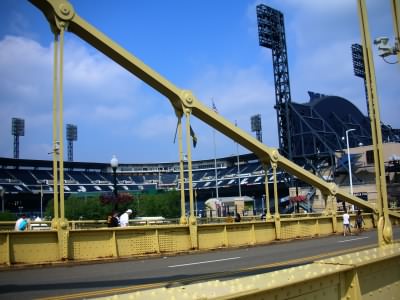
I paused at the entrance to PNC Park to snap a photo. Most people could surely not know what really interested me in the photo. When sailing, I keep a close eye on those flags. They tell me a lot about wind strength and direction. These flags were revealing a more Southerly wind than I'd expected.
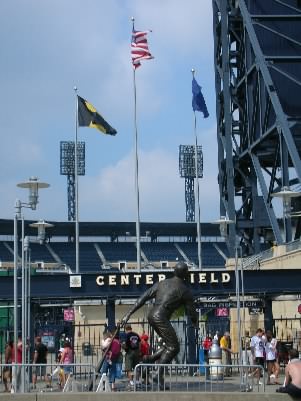
My next stops were along the riverfront, as I'd pause to take out my wind gauge. I could feel steady winds. The gauge assured me that they were running at 10-11 mph from what felt like the West. There were one or two gusts up to 15 mph and only a few whitecaps on the waves. That was reassuring. If there are too many white caps, then there is a more of wind than I want.

The next event was the opening of the Casino. The northern bank of the newborn Ohio river, just downstream of the Science Center, had been a construction zone for too long. The river trail has been blocked. The contractors just didn't think they needed to accommodate cyclists who might try to pass the obstacle they'd created and continue of the trail. The best solution they could come up for the problem they created was a sign shooing nuisance cyclists away.
Now I was to be cycling past within ten minutes of the official noon opening. I still couldn't cycle along a short stretch, since they were planning fireworks in a few moments. A detour of a few hundred feet took me right past the opening event, under the main entrance. Time to pause for another photo!
A few moments later I could cycle along the newly opened trail in front of the casino. No friend of the river would possibly like the huge parking structure they'd attached to the back of the casino. But the glass front and the curved trail really had gotten it right. This was a building that used the riverfront. There were restaurants filling the glass front, where patrons could sit and watch the walkers, runners and cyclists on the trail.
"Hmm," I thought, "this is just a two minute ride from where I dock my boat. Maybe this will be dinner one day!"
Arriving at Newport Marina moments later brought a happy surprize. I'd been storing my sailboat on its trailer at the water's edge. To launch it and retrieve it, I'd need to manhandle it off the trailer, slide it over grass and then over a one or two foot embankment into the water. I'd scavenged old sackcloth from a nearby dumpster and driftwood to protect the hull from rocks. But now, I found the boat enthroned on a slanted platform right at the water's edge. I'd just untie it and it would slide into the water. How easy! Thank you, Newport!

My only concern was stepping the mast. How easy would it be on this incline? I co-opted a nearby sailor as safety watch while I stepped the mast. It was a little harder, but manageable.
Finally the boat was rigged and I was in the water. Today I was pretty confident there's be no problem with lack of wind. Yet, once I was on the river, an unexpectedly weak breeze set me drifting upstream. That was odd given the strong winds I'd measured moments earlier at the Point. As the breeze slowed and died, I began to piece things together. Unlike recent days sailing, today's wind had a strong Southerly component. I looked up at the hill on the Southern shore of the Ohio--the same one in the photo above. It was blocking the wind so effectively that none was getting through. All that made it to the water were random puffs, often blowing in unexpected directions.
I now thought back to my first two failed attempts to sail on this stretch of the river. Then too there was a strong southerly component to the wind. So then I would have had the same confused, erratic wind. All that saved me this time was that there was also a Westerly component to many of the puffs, when they did happen. That was enough to blow me upstream. It was now clear to me that the early sailing disasters were no failing of my seamanship. This stretch of river is cursed.
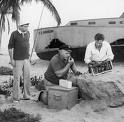
After a very slow and tense half hour, I finally made it to the better winds at the West End Bridge and beyond. I could now sail with the wind behind me. The boat shot off. My gps screen and its records afterwards showed me gaining 6 and 7 mph on the fastest legs, which is quite fast in a little boat. My goal was to make it as far as possible up the Allegheny. I'd been running its river trails for years. As I'd jog along, I'd look wistfully at the water and dream of what it would be like to be sitting right then in those waters in a sailboat. Today I would do it.
My course took me past the opening event of the casino, past the Pirates game, past the railway bridge at the Convention Center where I'd stalled on my last sail. It was energetic sailing. With the wind pretty much directly behind me, I was "running." In most sailboats, that means you extend the sail out to one or other side with the boom, which is just a stick that holds out the bottom edge of the sail. Booms are a mixed blessing. They are also the thing that hits you in the head if you don't keep your wits about you when the boat turns. My Hobie Bravo has no boom. That doesn't matter when I sail across the wind, but when I run, the sail tends to flap and fold over itself. I kept experimenting. I'd roll up the sail a little to see if that would help. It did, but I'd lose power when the wind dropped. Or I'd choose a more diagonal path. That helped too, but now I was losing the benefit of the run that would take me directly where I wanted to go.
After another hour or so of sailing, I was starting to worry about getting home. I budget 2 hours sailing into the wind to get home after each hour running before the wind. But what if today it was 3 or 4 hours? So I pulled the boat over to the shore in line with the Cork Factory Lofts, roughly at 23rd Street. There I awkwardly laid on my back on the deck, shooting photos blindly of the view downtown, across the river to the Cork Factory Lofts and upriver to Herr's Island/Washington's Landing, whose downstream point was now quite nearby.
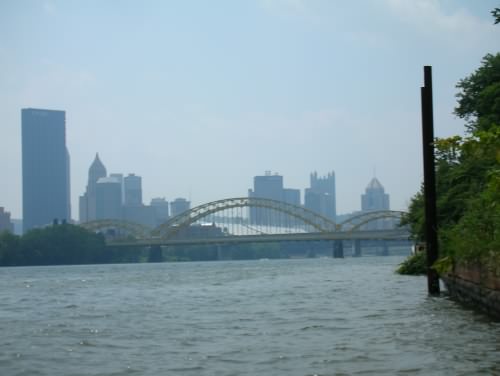
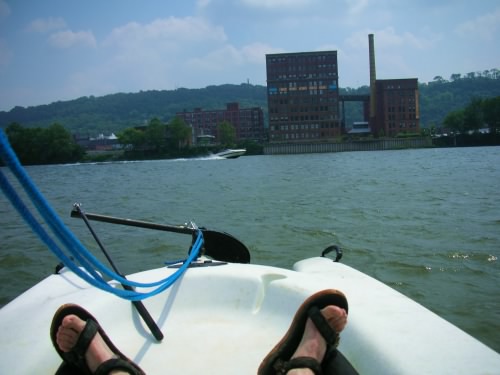
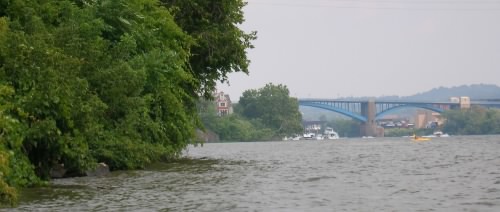
The warm weather was starting to catch up with me. I noticed how thirsty I'd become and I drank almost a full bottle of water.
To sail back, I'd need to sail directly into the wind. That is impossible, of course. I'd have to tack back and forth across the wind, never actually making a course that points directly into it. As I set off, it became clear to me that this was going to be hard work. The winds were blowing at a steady 10 mph. That should translate into fast sailing. It certainly had on the downwind leg. However I began to notice that I just wasn't going that fast. The problem started to become clear. First, I was at fault. In my eagerness to get back, I tended to steer just a little too close to the wind. That triggered "luffing" of the sails and set up an unpleasant rattle. Then the winds were kicking up a good chop. Now I needed to sail into those winds. And as wave after wave slapped against my bows, they would tap me back. It was a little like sailing uphill.
My gps was dutifully tracking my course. Here's the plot it gave
me on Google Earth. For a bigger image, click here.
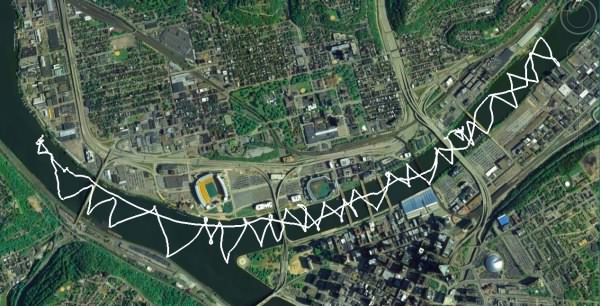
As with previous tracks, the straighter courses are me sailing downwind from West to East. The return against the wind is the zig-zag course.
(Update: The mystery of the slight mislocations of the track on the map is now solved. For corrected maps see here (satellite) and here (street).)
Tacking in light winds is pretty easy. You just point the bow towards the wind; it swings slowly past the wind; and you are going in the opposite direction. It was not so easy in these heavier winds. Once you turn the bow towards the winds, the stronger wind bleeds off your speed so fast that you lose control through the rudder; what makes it worse is that the slap of the waves is also slowing you. So an attempt to tack can fail. You have to try again. If the attempts keep failing, you can get into trouble. The river is only so wide and eventually you have to turn.
I called up all the tricks I knew. If the wind would drop briefly, I'd tack--take the chance when you get it. Or if there is a lee--a wind shadow with calmer winds--at the shore, sail to it and use it. Or if I can get close enough to the wind so that the wind pushes me straight back, just reversing the rudder brings the bow around. If all else fails, you can jibe. Instead of executing a 90 degree turn, as in the figure on the left, you go all the way round in the other direction, 270 degrees, as on the right.
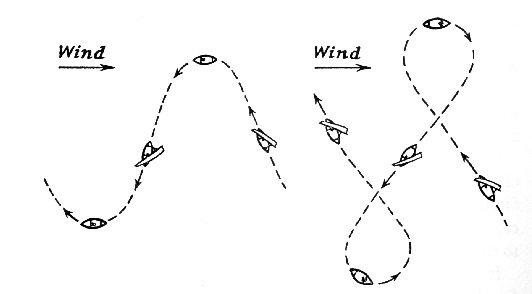
That is poor sailing. As your stern passes the wind, the sail will flip over or "jibe." If there is a boom on the sail, that is especially dangerous; and it also wears the sails. So everytime I did it, a little portion of my sailing self esteem was left in the water. The GPS track is amazingtly detailed. You can see each time that I jibed as a little loop in the tacking to and fro.
The whole excursion was proving energetic. The baseball game and the casino opening were drawing a steady stream of powerboaters. They flew past me, politely turning off a little, but never really enough to minimize the huge wakes. If I could, I'd turn into them. The bows go up and then down and then sometimes the wave breaks over the deck. It's warm, so I don't mind getting a little wet. I am also avoiding the larger boats.
At one point, I had to keep to the northern side of the river to avoid one of the big river boats and ended up, unable to tack, in the little channel under the Veteran's Bridge. I was stuck bows first in bushes at the riverside. A kindly powerboater came over and backed me out. I was very grateful!
Eve called to see how things were going. So I pulled over to the north shore between the 6th Street Bridge and the Duqesne Bridge and beached, furling the sail. It was good to get out and stretch my legs. I ate a power bar that was almost liquid in the heat of my little deck storage box.
There was still perhaps an hour's sailing home. The casino opening proved to be a full day's event. In the little amphitheater at the water's edge, they had set up a band, which was playing music loud enough to be heard over the water. I zig-zagged my way past, threading through a collection of boats anchored there to watch and listen. When I passed the West End Bridge into the accursed stretch, the wind just died. I sat there, alternating between being becalmed and feeling puffs of wind some from almost every direction. It seemed hopeless to figure out what would come next from where. So I took the cheapest solution. If you point the bows of a sailboat where you want to go and wait, you will likely get there eventually. If a puff comes from a favorable direction you will make some way. If the boat is poorly aligned to the wind when it comes, not much bad will happen. You just lose an opportunity.
When I docked, I noted that I'd been out on the water nearly four hours. My usual budget has worked well enough: one hour and bit downwind and two hours and a bit more upwind to get back. I was quite exhausted. The hot weather and the energies demanded by sailing had taken their toll. I retrieved the boat, tied it to its new slip and stored my gear. Eve had called. She was on the Southside in a coffee shop. Let's have dinner at the Double Wide Grill, she said. So I pedaled over, slumped at an outdoor table and ordered something with a lot of fat and calories. I was really hungry; and really sore. It had been four hours sitting on a hard deck, hauling ropes and hopping between positions; and then there was the launching and retrieving and miles of bike riding.
On the way over, I'd emptied the bike saddle bags of sailing gear. After eating we stopped at the supermarket and filled them with groceries. To answer a question downtown residents often get, that is one way we shop.
John D. Norton
Back to main